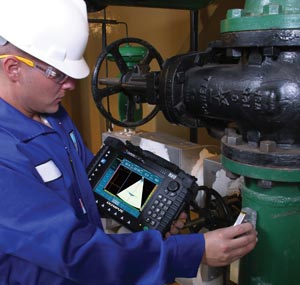Anatomy of Phased Array Display
This section provides further insight into how phased array images are constructed. In particular, it will further explain required inputs, and the relationships of the various phased array display types with respect to the actual probe assembly and part being inspected. We will also explain the typically available A-scan views associated with the phased array image.
Required Considerations for Proper Inspection

As discussed previously, there are many factors that need to be identified in order to properly perform any ultrasonic inspection. In summary, there are material specific characteristics and transducer characteristics needed for calibrating the instrument for a proper inspection.
Material:
- Velocity of the material being inspected needs to be set in order to properly measure depth. Care must be taken to select the proper velocity mode (longitudinal or shear). As you may recall, compressional straight beam testing typically uses longitudinal waves while angle beam inspection most often uses shear wave propagation.
- Part thickness information is typically entered. This is particularly useful in angle beam inspection. It allows proper depth measurement relative to the leg number in angle beam applications.
- Radius of curvature should be set considered when inspecting non-flat parts. This curvature can be algorithmically accounted for to make more accurate depth measurements.
Transducer:
- Frequency must be known to allow for proper pulser parameters and receiver filter settings.
- Zero Offset must be established in order to offset electrical and mechanical delays resulting from coupling, matching layer, cabling and electronic induced delays for proper thickness readings.
- Amplitude response from known reflectors must be set and available for reference in order to use common amplitude sizing techniques.
- Angle of sound beam entry into the material being inspected.
- For phased array probes, the number elements and pitch need to be known.
Wedge:
- Velocity of sound propagation through the wedge
- Incident angle of the wedge.
- Beam index point or front of probe reference.
- First element height offset for phased array.
In conventional ultrasonic testing, all of the above steps must be taken prior to inspection to achieve proper results. Since a single element probe has a fixed aperture, the entry angle selection, zero offset, and amplitude calibration are specific to a single transducer or transducer/wedge combination. Each time a transducer or its wedge is changed, a new calibration must be performed.
Using phased array probes, the user must follow these same principles. The main advantage of phased array testing is the ability to change aperture, focus, and/or angle dynamically, essentially allowing the use of several probes at one time. This imparts the additional requirement of extending calibration and setup requirements to each phased array transducer state (commonly referred to as a focal law). This not only allows accurate measurements of amplitude and depth across the entire
programmed focal sequence, but also provides accurate and enhanced visualization via the natural images that phase array instruments produce.
One of the major differences between conventional and phased array inspections occurs in angle beam inspection. With conventional UT, input of an improper wedge angle or material velocity will cause errors in locating the defect, but basic wave propagation (and hence the resultant A-scan) is not influenced, as it relies solely on mechanical refraction. For phased array however, proper material and wedge velocities along with probe and wedge parameter inputs are required to arrive at the proper
focal laws to electronically steer across the desired refracted angles and to create sensible images. In more capable instruments, probe recognition utilities automatically transfer critical phased array probe information and use well-organized libraries to manage the selection of wedge parameters.
The following values must normally be entered in order to program a phased array scan:
Probe Parameters:
Frequency
Bandwidth
Size
Number of elements
Element pitch
Wedge Parameters:
Incident angle of the wedge
Nominal velocity of the wedge
Offset Z = Height to center of first element
Index offset X = distance from front of wedge to first element
Scan offset Y = distance from side of wedge to center of elements

Continue on to
Focal Law Setup>>